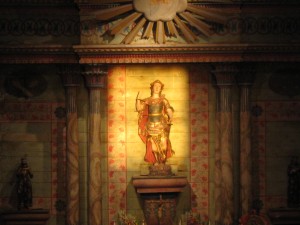
For centuries, California’s missions have stood as historic state landmarks, and windows into the state’s past. But a new understanding of the aging buildings is emerging. Archeologist Ruben Mendoza of California State University Monterey Bay says the missions have hidden a secret for centuries — one involving everything from advanced astronomy in the supposedly science-averse church, to appeals to paganism by Catholic padres seeking converts in the new world.
Mendoza is studying recently discovered “illuminations,” which are alignments of missions’ main windows such that they project a beam of light onto statues of saints and containers of the Eucharist on holy days. The effect is present in many missions throughout California and even some in Latin America.
Mendoza believes the effect is intentional, and that it shows that the padres who founded the missions were using the sun to keep hyper-accurate church calenders synchronized. It also emphasizes the sun in Catholic masses, in order to win over native peoples in America, many of which engaged in sun-worship.
This video explores the phenomenon as well as the curiosity, support and criticism Mendoza’s theory has sparked.
[youtube]S4rQwHwe8uE[/youtube]
Editor’s Note: In the year 1809, when the Mission Church was completed and dedicated, the dedication took place on the Feast Day of St. Joseph, which in 1809 was celebrated on April 22, contrary to the speaker in the video.

Not shocking at all. The Spanish were in Mexico before California, where these kinds of things were used to calibrate the calendar by indigenous people.
Even today, one can travel to these places in Mexico and see the calendar calibrations with the sun moving during Solstices.
Perhaps it was a replica or perhaps it was done by the Indians without the Catholic church understanding??? I don’t know enough to say.
The sun wasn’t worshiped per say, we’d worship it to if it went out. It was used to calibrate time, mark farming cycles. At Teotihuacan shows, the Sun, Moon, and many natural elements were appreciated, like our Ipods today.
Cross cultural research like this will help. Nice video. Thank you!
What doesn’t seem to be stressed here is the fact that our California Missions were reconstructed in the 1930’s, primarily by the Irish construction industry during the Depression. It put men to work, and it was a tribute to their faith. (I don’t know if they were even paid!) In any case, many ideas for reconstruction were brought in, although the attempt was made to keep the original adobe bricks, made new by hand in the 1930’s.
What needs to be analyzed is clear: are these Mission churches we have now the same as the ones that were there in the original 1770’s-1810’s? Could the Irish or some other group have brought in this idea?
The priests and monks of those times were not builders. Artisans were brought up from Mexico to help in their construction, to give instructions on the brickmaking and so on to the Indian laborers. Two-story structures were not possible; the barracks at the Sonoma Mission, on the plaza, was the work of American re-builders.
So, does this matter?
I daresay it does. It means that our Missions are not the real ones.
In Mexico, respect for the old Missions has been minimal. They’re collapsing or totally decayed into piles of dust and stone. Our Mexican tourists are astounded at our US efforts to restore and rebuild from scratch, to even care about the Spanish Colonial influence.
But perhaps it’s not really a “U.S.” phenonmenon, rather a Celtic one. And you know those Celts! They were pagans alright!
Mr. Jones,
Where did you get the idea the Church was “science averse”?
You don’t need archaeological evidence to realize Mother Church kept classical learning alive in the West after the fall of the Roman order and extended it over the following centuries. A quick review of this article (http://en.wikipedia.org/wiki/University) will give you a list of major European universities founded before the 14th century. I suspect you might even recognize some of them.
I do hope your comment isn’t a reflection of your own ignorance projected on to others, both past and present.